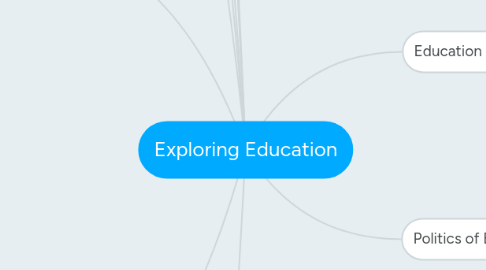
1. Philosophy of Education
1.1. Pargmatism
1.1.1. American Philosophy being in 19th century
1.1.2. Founders for Pragmatism as well as reserchers
1.1.2.1. George Sanders Pierce (1839-1914)
1.1.2.2. William James (1842-1910)
1.1.2.3. John Dewey (1859-1952)
1.2. Generic Notion
1.2.1. Dewey's form of Pragmatism
1.2.1.1. Instrumental
1.2.1.2. Experinmentalism
1.2.2. Created on Psychology and Behavior
1.2.3. Dewey's ideas were influenced by the belief in progress toward optimism
1.2.4. Dewey's ideas on education were thought to be progressive.
1.2.4.1. Experimental learning
1.2.4.2. Group learning
1.2.4.3. Students involved in class planning and course of study
1.3. Goal of Education
1.3.1. Dewey's belief was to balance the social and communities on one hand as well as that of the individual
1.3.2. Integrate children into a democratic society
1.3.3. Dewey stressed the importance of the school as a place where ideas can be implemented, challenged, and restructured, while embracing the goal of a new social order
1.4. Role of Teacher
1.4.1. The teacher is no longer the source from which knowledge flows
1.4.2. The teacher assumes the role as a facilitator
1.4.3. Teacher encourages, offers suggestions, questions, and aids in the course of study
1.4.4. Teachers write curriculum and commands discipline in order to create and implement a curriculum.
1.5. Method of Instuction
1.5.1. Dewey proposed children learn in groups as well was individually
1.5.2. Students would pose questions about things they want to know
1.5.3. Problem solving or injury method
1.5.4. Formal instruction
1.6. Curriculum
1.6.1. Follow Dewey's idea of core curriculum or an integrated curriculum
1.6.2. Working from the known to the unknown
1.6.3. Expanding Enviorments
1.6.4. Progressive educators are not yoked to a fixed curriculum
1.6.5. Child centered
2. Schools of Organization
2.1. Openness
2.1.1. Schools are made to ensure students have multiple opportunities for their advancement
2.1.1.1. Advanced diploma
2.1.1.2. Standard diploma
2.1.1.3. Drop out
2.1.2. Arranged
2.1.2.1. Elementary (K-5)
2.1.2.2. Middle School (6-8)
2.1.2.3. High School(9-12)
2.2. Government
2.2.1. Federal
2.2.1.1. Limited funds toward Education
2.2.1.2. Limited authority in government when it comes to education
2.2.2. State
2.2.2.1. More funds available than in Federal
2.2.2.2. Maintains curriculum, safety, codes, and skills for teaching
2.2.3. District
2.2.3.1. Most of funds for schools come from taxpayers
2.2.3.2. Mandates made are carried out by citizens of a district
3. Curriculum and Pedagogy
3.1. Sodology of Curriculum
3.1.1. Believe that the curriculum of the school includes both what is formally included as the subject matter learned the formal curriculum as well as the informal and hidden curriculum
3.1.2. Focus is not only on what is taught, but why?
3.2. What is taught by schools
3.2.1. Curriculum is simplified and tends to ignore political and social aspects of what is being taught
3.2.2. Curriculum is defined as an objective and organized body of knowledge to be taught to the students
3.2.3. Schools are required to teach a certain curriculum. Which has to be reviewed by the state and then implemented in the schools
3.3. Politics of Cirriculum
3.3.1. Frequently asked question: Who shapes the Curriculum?
3.3.2. What values are represented?
4. Educational Inequailty
4.1. Cultural Difference Therory
4.1.1. Working class and non-white children
4.1.1.1. Arrive at school with different culture disspostions
4.1.1.2. Minority oppressed
4.1.2. Students in lower sodoeconomic backgrounds face problems in their communities due to:
4.1.2.1. Social and Institutional process
4.1.2.2. Race
4.1.2.3. Poverty
4.2. Does schools reproduce inequality?
5. Education Reform
5.1. Race to the top
5.1.1. Many states adopted common core standards
5.1.2. Grants will aide states while they work to meet the NCLB guild lines, improve student outcomes, and eliminate achievement gaps
5.2. No Child Left Behind (NCLB)
5.2.1. Mandates the uniform standards for all students in order to reduce and eventually eliminate the social class and race achievement gap in 2014
5.2.2. Has historically undeserved low income and minority children through curriculum tracking, poor instruction, and low quality teachers in urban schools
6. Equality of Opportunity
6.1. Students with special needs
6.1.1. Congress passed the Education of all handicapped children Act in 1975
6.1.2. Parents tend to pressure the educational system when having a special needs child
6.2. Class
6.2.1. Different social classes have different experiences
6.2.1.1. Teachers expect more from middle and upper class students and are given more attention
6.2.1.2. Wealthier family better education
6.2.1.3. More chances middle and upper class kids are going to college and earning a degree
7. Sociological Prespectivies
7.1. Three effects of schooling that have an impact:
7.1.1. Environment
7.1.2. Technology
7.1.3. Religion
7.2. Helps provide general social patterns in behavior of individuals
7.3. Encourages everyone to realize that society guides our thoughts and needs
8. Founders of Progressivism are John Dewey and Francis Parker.
9. Traditional teaching is too boring. It's how the student learns and adapts to help others. Not vise versa
10. Education and it's history
10.1. Brown vs. the Board of Education
10.1.1. The landmark case that schools for blacks and whites unconstitutional
10.2. Horace Mann
10.2.1. Founded the American Public school system
10.3. Piessy vs. Ferguson
10.3.1. upheld the state law requiring racial segregation in public facilities under the "separate not equal" doctrine
10.3.1.1. a movement that won support to make education for all childern

